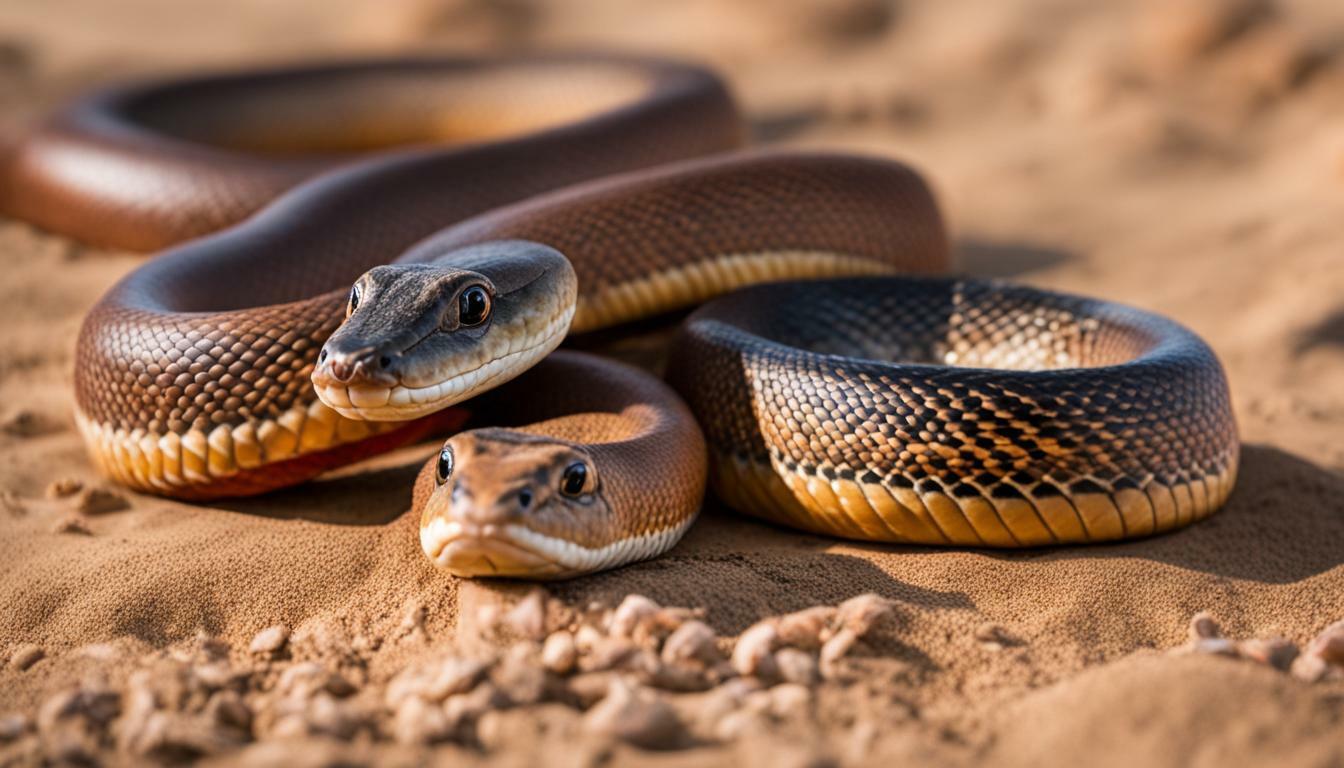Box turtles are fascinating creatures that are native to North America. With over four different species of box turtles inhabiting the continent, distinguishing one from the other can be quite a challenge. In this article, we’ll be focusing on the Eastern and Western Box Turtles, exploring their unique differences and characteristics.
While Eastern and Western Box Turtles share some similarities, such as their ability to retract their heads and limbs into their shells for protection, there are also significant differences between the two species. From their physical appearance to their habitat preferences, Eastern and Western Box Turtles have unique features that set them apart.
Key Takeaways
- The Eastern and Western Box Turtles are two different species of box turtles found in North America.
- While they share some similarities, there are significant differences in their physical appearance and habitat preferences.
- Learning to distinguish between the two species is important for anyone interested in studying or keeping box turtles as pets.
Eastern Box Turtle: An Eastern Delight
Out of the two species, Eastern Box Turtles are the most commonly kept as pets. They are treasured for their attractive and intricate shell markings and their gentle, docile personalities.
The Eastern Box Turtle is a member of the genus Terrapene, known for being land-based turtles. They have high and arched shells that are usually brown in color with bright yellow or orange spots on the scutes (the individual sections of the shell). Their plastrons (underside of the shell) are often yellow or brown, with black marks that outline their section, unlike the Western Box Turtle, whose plastron is generally more uniform.
Eastern Box Turtles are relatively small, usually measuring five to six inches in length, but can grow up to seven inches long. They have a lifespan of around 25 to 30 years in captivity, but can live up to 100 years in the wild.
These turtles are omnivorous and eat a variety of plant and animal matter, including fruits, vegetables, insects, and small mammals. Interestingly, Eastern Box Turtles have a highly evolved sense of smell and can locate food from over 50 yards away.
When it comes to behavior, Eastern Box Turtles are known for their unique mating habits. Males constantly circle around a female before mating, and females are known to store sperm for up to four years. They are also known for their ability to hibernate for long periods, up to six months in some cases.
The Eastern Box Turtle’s preferred habitat is deciduous forests with plenty of cover and moisture. They require a shallow water source, such as a small pond, to soak in and keep their skin hydrated. They also need an area to bask in the sun to regulate their body temperature.
If you are looking for a captivating and charming pet, the Eastern Box Turtle is an excellent choice. They are fascinating creatures with unique traits that make them stand out from other box turtle species.
Western Box Turtle: A Western Gem
The Western Box Turtle is a fascinating species that boasts unique physical attributes and intriguing behaviors. Unlike the Eastern Box Turtle, the Western Box Turtle has a more flattened shell with a more pronounced keel. Additionally, the Western Box Turtle has a less domed carapace and a longer tail.
These turtles are found in a wide range of habitats, including grasslands, deserts, and woodlands. They prefer areas with adequate cover, such as logs, rocks, and vegetation, where they can retreat to protect themselves from predators and extreme weather conditions.
Western Box Turtles have diverse diets, and their preferences vary depending on their natural habitat. They typically feed on a mix of animal-based foods, such as insects, snails, and worms, as well as plant matter like berries, mushrooms, and grasses.
One of the most unique aspects of Western Box Turtles is their ability to regulate their body temperature. They are ectothermic, which means that they rely on external sources to regulate their body temperature. During the hottest part of the day, Western Box Turtles will seek out cooler areas such as under bushes or in the shade to avoid overheating. On cooler days, they bask in the sun to warm up and increase their body temperature.
Another interesting characteristic of Western Box Turtles is their long lifespan. These turtles can live up to 40 years in the wild and over 100 years in captivity.
| Western Box Turtle Facts |
|---|
| The Western Box Turtle has a more flattened shell with a pronounced keel. |
| They prefer areas with adequate cover, such as logs, rocks, and vegetation. |
| They have diverse diets and consume a mix of animal-based and plant matter. |
| They regulate their body temperature through basking and seeking out cooler areas. |
| They have a long lifespan of up to 40 years in the wild and over 100 years in captivity. |
Overall, the Western Box Turtle is a remarkable species with unique characteristics that set it apart from its Eastern counterpart. By understanding their habits and preferences, we can appreciate the importance of these turtles and their role in maintaining a healthy ecosystem.
Eastern vs Western Box Turtle Habitat
Both Eastern and Western Box Turtles have specific habitat preferences. Eastern Box Turtles are commonly found in forests, grasslands, and wetlands. They are also known to occupy human-made habitats such as parks and suburban lawns. On the other hand, Western Box Turtles prefer dry, arid regions such as deserts, grasslands, and scrubland.
Eastern Box Turtles are known for their ability to adapt to a wide range of environments. They can withstand different temperature ranges and live in areas with varied humidity levels. Western Box Turtles have a slightly narrower tolerance for environmental conditions and are less adaptable.
Eastern vs Western Box Turtle Habitat Comparison
| Eastern Box Turtle | Western Box Turtle |
|---|---|
| Forests, grasslands, and wetlands | Deserts, grasslands, and scrubland |
| Adaptable to a wide range of environments | Narrower tolerance for environmental conditions |
The habitat differences between Eastern and Western Box Turtles have an impact on their behavior and physical characteristics. Eastern Box Turtles are more likely to hibernate during winters, while Western Box Turtles brumate underground during droughts. The environmental conditions also influence the diet of each species, with Eastern Box Turtles consuming a more varied diet that includes fruits, vegetables, and invertebrates.
Understanding the habitat preferences and environmental requirements of Eastern and Western Box Turtles is crucial when it comes to conservation efforts. These species face numerous threats, including habitat loss and fragmentation, and it is essential to protect their habitats to ensure their survival.
Box Turtle Identification: Spotting the Differences
Identifying Eastern and Western Box Turtles can be challenging, but with the right knowledge, it can be easy. Here are some of the key characteristics of each species.
Eastern Box Turtles
The Eastern Box Turtle is smaller and has a more domed shell than the Western Box Turtle. The shell’s background color is brown or black and is adorned with yellow or orange markings. Some individuals may have speckles or blotches, while others may have none. The plastron or the bottom shell is hinged and features a pattern of black and yellow lines.
Eastern Box Turtles also have a distinct head, with a high, dome-like shape and a yellow or orange iris. Males typically have a red or pink iris.
Western Box Turtles
The Western Box Turtle has a flatter shell than the Eastern species, and its underbelly is significantly more prominent. The background color is brownish or olive, with a pattern of yellow or orange blotches and stripes. Some individuals may have speckled patterns, while others may have none. The plastron may have a pattern of dark lines, and the hinge may be less pronounced than in the Eastern species.
Western Box Turtles have a blocky head, and the iris ranges from dark brown to black. Males typically have red or orange eyes.
Knowing the differences between Eastern and Western Box Turtles is crucial for their conservation and protection. Be sure to report any sightings of these iconic creatures to the appropriate authorities.
Eastern Box Turtle vs Western Box Turtle: A Comparative Analysis
Eastern and Western Box Turtles share several similarities despite their differences, such as their temperament and the ability to retract their head, legs, and tail inside their shell for protection. However, certain distinguishing characteristics set them apart.
| Comparison Factors | Eastern Box Turtle | Western Box Turtle |
|---|---|---|
| Size | Eastern Box Turtles are relatively smaller, measuring between 4.5 to 6 inches. | Western Box Turtles are larger, reaching up to 7 to 9 inches in size. |
| Coloration | Eastern Box Turtles have yellow and orange blotches on their carapace and a darker head. | Western Box Turtles have a lighter shell, with yellow markings on the legs and head. |
| Habitat | Eastern Box Turtles prefer living in wooded areas, while also being found near fields and wetlands. | Western Box Turtles prefer living in grasslands and open forests. |
| Diet | Eastern Box Turtles feed on a varied diet consisting of insects, fruits, berries, mushrooms, and plants. | Western Box Turtles have a similar diet but prefer eating more insects and grasses. |
| Reproduction | Eastern Box Turtles reach sexual maturity between the ages of 7 to 10 years. Females lay 3 to 8 eggs annually during the nesting period, typically from May to July. | Western Box Turtles reach sexual maturity around the age of 8 years, with females laying up to 5 eggs from May to June. |
While both types of box turtles are fascinating creatures, their differences allow them to thrive in distinct regions of the United States.
Conclusion
In conclusion, Eastern and Western Box Turtles are two distinct species with unique traits and characteristics. While they may have similar appearances, their behaviors, diets, and preferred habitats set them apart from each other.
Through this article, we have explored the differences between Eastern and Western Box Turtles in detail. We have learned about the environmental preferences of each species and how they adapt to their surroundings. We have gained valuable insights into their physical attributes, shell patterns, coloration, and other unique traits.
Appreciating the Diversity of Box Turtles
Box Turtles play a vital role in the ecosystem, and it is essential to appreciate their diversity. Each species has its unique characteristics that make them fascinating. By understanding the distinctive traits of Eastern and Western Box Turtles, we can appreciate their value.
We hope this article has provided valuable insights into the world of box turtles and helped you understand the differences between Eastern and Western Box Turtles.
FAQ
Q: What are the main differences between Eastern and Western Box Turtles?
A: Eastern and Western Box Turtles differ in their habitat preferences, physical appearance, and behaviors. Eastern Box Turtles are typically found in forests and grasslands, while Western Box Turtles inhabit arid regions. Eastern Box Turtles have a high-domed carapace with dark brown or black markings, while Western Box Turtles have a flatter carapace with lighter colors. Behaviorally, Eastern Box Turtles are more likely to be active during the day, while Western Box Turtles are more active during the early morning and late afternoon.
Q: What are some interesting facts about Eastern Box Turtles?
A: Eastern Box Turtles are long-lived, with some individuals living more than 100 years. They have the ability to retract their heads, legs, and tail into their shell for protection. Eastern Box Turtles are omnivorous, feeding on a diet of plants, insects, worms, berries, and mushrooms. They are known to have a strong homing instinct and can often find their way back to their original habitat, even after being moved.
Q: What are some unique traits of Western Box Turtles?
A: Western Box Turtles are well adapted to arid environments and have the ability to dig burrows to escape extreme temperatures. They have a flatter carapace compared to Eastern Box Turtles, which helps them navigate rocky terrain. Western Box Turtles are also known for their bright yellow or orange markings on their skin and shell, adding to their unique appearance.
Q: How do Eastern and Western Box Turtles differ in their habitat preferences?
A: Eastern Box Turtles are typically found in woodland areas, forests, and grasslands with access to freshwater sources. They prefer habitats with moist soil and ample vegetation for foraging. On the other hand, Western Box Turtles inhabit arid regions such as deserts, semi-arid grasslands, and scrublands. They can tolerate drier conditions and are often found in rocky areas.
Q: What are some key characteristics to identify Eastern and Western Box Turtles?
A: Eastern Box Turtles have a high-domed carapace with dark brown or black markings, often resembling a tortoiseshell pattern. They have a brightly colored head and neck, with males having red eyes and females having yellow-brown eyes. Western Box Turtles have a flatter carapace with lighter colors, often with yellow or orange markings. Their heads are usually dark-colored, and their eyes are reddish or brown.
Q: How do Eastern and Western Box Turtles differ behaviorally?
A: Eastern Box Turtles are diurnal, meaning they are active during the day. They are known to be more social and may gather in groups during certain times of the year. Western Box Turtles, on the other hand, are crepuscular, meaning they are more active during the early morning and late afternoon. They are generally more solitary and less social compared to Eastern Box Turtles.
Q: In what ways are Eastern and Western Box Turtles similar?
A: Both Eastern and Western Box Turtles are terrestrial species, spending the majority of their lives on land. They are omnivorous, feeding on a combination of plant matter, insects, worms, and other small creatures. Both species also have the ability to retract their heads, legs, and tail into their shell for protection.
 Skip to main content
Skip to main content


